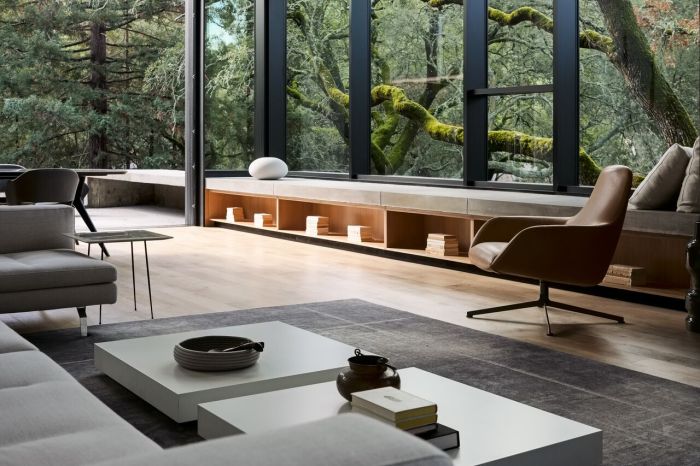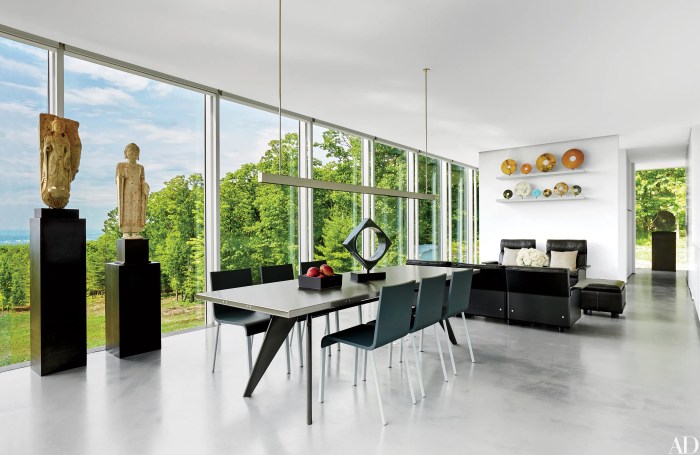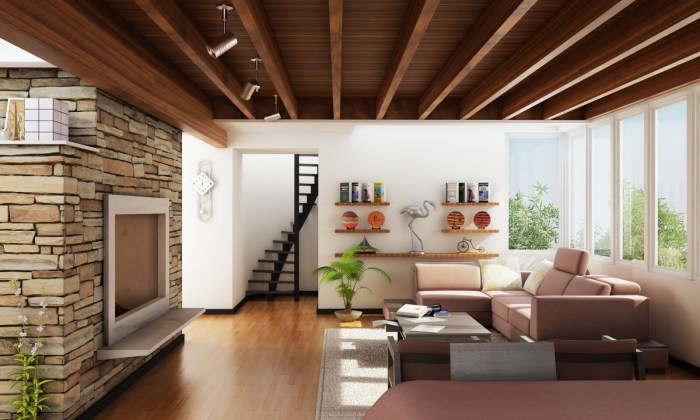Unlocking the World of Interior Architecture

Interior architecture sets the stage for this enthralling narrative, offering readers a glimpse into a story that is rich in detail and brimming with originality from the outset. As we delve into the complexities of this field, we uncover a world where design meets functionality in a seamless blend of creativity and purpose.
Exploring the different facets of interior architecture reveals a dynamic interplay between aesthetics and practicality, where every space tells a unique story crafted with precision and ingenuity.
Definition and Overview
Interior architecture refers to the design and coordination of interior spaces within buildings. It focuses on enhancing the functionality and aesthetic appeal of indoor areas, considering aspects like layout, lighting, materials, and spatial configuration. In the design world, interior architecture plays a crucial role in creating harmonious and innovative environments that meet the needs and preferences of occupants.Interior architecture differs from interior design in that it involves a more technical and structural approach to space planning.
While interior design focuses on the decorative aspects of a space, such as furniture, color schemes, and accessories, interior architecture deals with the overall design of the interior structure, including walls, ceilings, and floors.
Examples of Famous Interior Architecture Projects and Their Impact
- The Guggenheim Museum in Bilbao, Spain: Designed by architect Frank Gehry, this iconic building is a masterpiece of interior architecture, with its innovative use of titanium panels and curved forms creating a dynamic and visually striking interior space.
- The Sydney Opera House in Australia: Renowned for its unique shell-like structures and sweeping rooflines, this architectural marvel by Jørn Utzon showcases the integration of interior and exterior spaces, creating a seamless connection between the building and its surroundings.
- The Burj Khalifa in Dubai, UAE: As the tallest building in the world, the Burj Khalifa features a sophisticated interior design that reflects the luxurious lifestyle of its residents and visitors. The interior architecture of this skyscraper includes high-end finishes, panoramic views, and state-of-the-art amenities.
Elements of Interior Architecture
Interior architecture is composed of various essential components that work together to create functional and aesthetically pleasing spaces. These elements are crucial in shaping the overall design and experience of a built environment.
Materials and Finishes
Materials and finishes play a significant role in interior architecture, as they contribute to the overall look, feel, and functionality of a space. Interior architects carefully select materials such as wood, metal, glass, and stone, considering factors like durability, maintenance, and sustainability.
Finishes like paint, wallpaper, flooring, and textiles add texture, color, and visual interest to the design. The choice of materials and finishes can greatly impact the mood, style, and quality of an interior space.
Lighting Design
Lighting design in interior architecture differs from interior design in its focus on both functional and aesthetic considerations. Interior architects strategically plan the placement, type, and intensity of lighting fixtures to enhance the atmosphere, highlight architectural features, and support the activities within a space.
Lighting design in interior architecture also involves addressing natural light sources, artificial lighting systems, and energy efficiency. By carefully designing the lighting scheme, interior architects can create dynamic and inviting environments that respond to the needs and preferences of the users.
Spatial Planning and Functionality
Spatial planning plays a crucial role in interior architecture as it involves organizing and arranging spaces to optimize functionality and efficiency. By strategically planning the layout of a space, interior architects can enhance the overall user experience and ensure that the design meets the needs of the occupants.Functionality is a key consideration in interior architecture designs as it directly impacts how a space is used and experienced.
Designing with functionality in mind involves creating spaces that are practical, comfortable, and efficient for the intended purpose. For example, in a residential setting, a well-designed kitchen layout that prioritizes workflow and storage can greatly enhance the user experience.Finding the balance between aesthetics and practicality is essential in interior architecture.
While aesthetics focus on the visual appeal and style of a space, practicality ensures that the design is functional and serves its intended purpose. Striking the right balance between the two aspects is crucial to creating successful interior architecture designs that are both visually pleasing and highly functional.
Sustainability and Interior Architecture
When it comes to modern interior architecture practices, sustainability plays a crucial role in shaping design decisions and project outcomes. Interior architects are increasingly integrating sustainable principles into their work to reduce environmental impact and create healthier spaces for occupants.
Role of Sustainability in Interior Architecture
One of the key aspects of sustainability in interior architecture is the use of eco-friendly materials and construction methods. By opting for materials that are renewable, recyclable, or locally sourced, interior architects can minimize the carbon footprint of their projects.
Additionally, incorporating energy-efficient systems and natural lighting solutions can further enhance the sustainability of interior spaces.
Impact of Sustainable Materials and Design Choices
- Utilizing recycled or upcycled materials in interior design not only reduces waste but also adds a unique aesthetic appeal to spaces.
- Choosing low-VOC (volatile organic compound) paints and finishes contributes to better indoor air quality, promoting the health and well-being of occupants.
- Integrating biophilic design elements, such as indoor plants and green walls, not only enhances the visual appeal of interiors but also improves air quality and overall comfort.
Innovative Sustainable Design Practices
- Implementing passive design strategies like natural ventilation and thermal mass to reduce the need for artificial heating and cooling.
- Designing multifunctional spaces that optimize square footage and serve multiple purposes, promoting efficiency and minimizing resource consumption.
- Collaborating with suppliers and manufacturers to source sustainable materials and furniture, ensuring a holistic approach to sustainability throughout the project.
Technology Integration

In the world of interior architecture, technology plays a crucial role in enhancing the design process and overall outcome of projects. From virtual reality to Building Information Modeling (BIM), the integration of technology has revolutionized the way interior architects work and collaborate with clients.
Virtual Reality and Augmented Reality in Interior Architecture
Virtual reality (VR) and augmented reality (AR) have become invaluable tools for interior architects to visualize and present their designs to clients. By creating immersive and interactive experiences, VR and AR allow clients to walk through a space before it is even built, providing a better understanding of the design concept.
This technology not only enhances communication between designers and clients but also helps in identifying any potential issues or improvements in the design before construction begins.
Building Information Modeling (BIM) in Interior Architecture
Building Information Modeling (BIM) has transformed the way interior architects plan, design, construct, and manage buildings. By creating a digital representation of the physical and functional aspects of a project, BIM allows designers to collaborate in real-time, optimize spatial planning, and analyze the performance of a design before it is built.
This technology enables a more efficient and sustainable approach to interior architecture, minimizing errors and reducing costs throughout the project lifecycle.
Cultural Influences and Interior Architecture

Interior architecture is heavily influenced by culture and heritage, reflecting the values, traditions, and beliefs of a society. The design of interior spaces often incorporates elements that are significant to the culture they belong to, creating a sense of identity and belonging for the people who inhabit these spaces.
Examples of Cultural Representation in Interior Architecture
- In Japan, traditional tatami mats and sliding doors known as Fusuma are commonly used in interior design, reflecting the minimalist and nature-inspired aesthetics of Japanese culture.
- In Morocco, vibrant colors, intricate patterns, and geometric shapes are prominent features in interior architecture, showcasing the rich cultural heritage of the region.
- In Scandinavia, the concept of hygge, which emphasizes coziness and comfort, is reflected in interior design through the use of natural materials, soft textures, and warm lighting.
The Importance of Cultural Sensitivity in Interior Design
Interior designers must be culturally sensitive when creating spaces that are meant to be experienced by individuals from diverse backgrounds. By understanding and respecting the cultural norms, values, and traditions of a specific community, designers can ensure that their designs are inclusive and respectful of different ways of living and being.
Summary

In conclusion, interior architecture emerges as a captivating realm where innovation and tradition intersect, shaping environments that not only inspire but also serve a functional purpose. As we continue to evolve in our understanding of design, the essence of interior architecture remains a timeless beacon of creativity and sophistication.
General Inquiries
What is the role of materials in interior architecture?
Materials play a crucial role in interior architecture, defining the texture, color, and overall feel of a space while also influencing its durability and sustainability.
How does cultural sensitivity impact interior architecture designs?
Cultural sensitivity in interior architecture involves respecting and incorporating cultural elements, traditions, and values into the design process to create spaces that resonate with diverse audiences.
What are some innovative ways interior architects promote sustainability?
Interior architects promote sustainability through the use of eco-friendly materials, energy-efficient design practices, and incorporating renewable resources into their projects.

